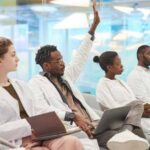Opportunities to Show We Care
Unfortunately, a lot of the physical examination has been sterilized into a set of diagnostic procedures. In particular, the Journal of the American Medical Association (JAMA) published a series about the rational clinical examination, which discussed physical examination maneuvers as diagnostic tests.7 Not surprisingly, most of the maneuvers did not have characteristics specific or sensitive enough for deployment in diagnostic settings. Yet this misses the point.
When I shake a patient’s hand, I am not looking to establish the diagnosis of rheumatoid arthritis or psoriatic arthritis. What I am looking for are the subtle, barely noticeable signs of human disease and well-being. How firm is the patient’s grip? Is there even the slightest grimace on their face? Can I feel the contours of hypermobility? Do the fingers align roughly well, or are there signs of deformity? What stiffness is detectable at the wrist or even shoulder level? Are hints of systemic disease visible in their fingernails? While it would be nice to know the receiving characteristics of a standardized handshake, I doubt there is any good experimental design to detect the effectiveness of a handshake for physical examination purposes.
I don’t keep these observations to myself. In an age that prioritizes equity and inclusivity, I make sure to inform patients that this handshake is more than just a formality. I tell them, usually a little afterward, exactly what I felt and saw when I shook their hands. It’s a sign of appreciation for their time that I am prioritizing every opportunity to understand who they are. At the same time, it draws out stories and narratives that might otherwise be missing. For example, a tattoo on the finger can tell volumes about a patient’s values, or a sole fingernail painted black can lead to a very personal story the patient is waiting to tell you.
Priming the Examination
Of course in and of itself, a handshake is insufficient for a regional musculoskeletal physical examination. But it is an important initial step. I usually use the data from the handshake to gauge how to later approach the more systemic finger-by-finger, joint-by-joint examination. If the handshake was very delicate, I make sure my touch is gentler than usual so as not to elicit as much pain. If the handshake was more vigorous, I take greater effort to find more subtle signs of swelling and tenderness.


